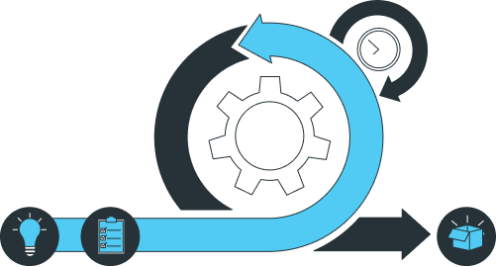For many marketers, “conversion” is the undeniable key to success. It is in fact, a key concept in digital strategies, and for a good reason: if your marketing campaign fails to convert prospects into customers, your efforts (and investments) are wasted.
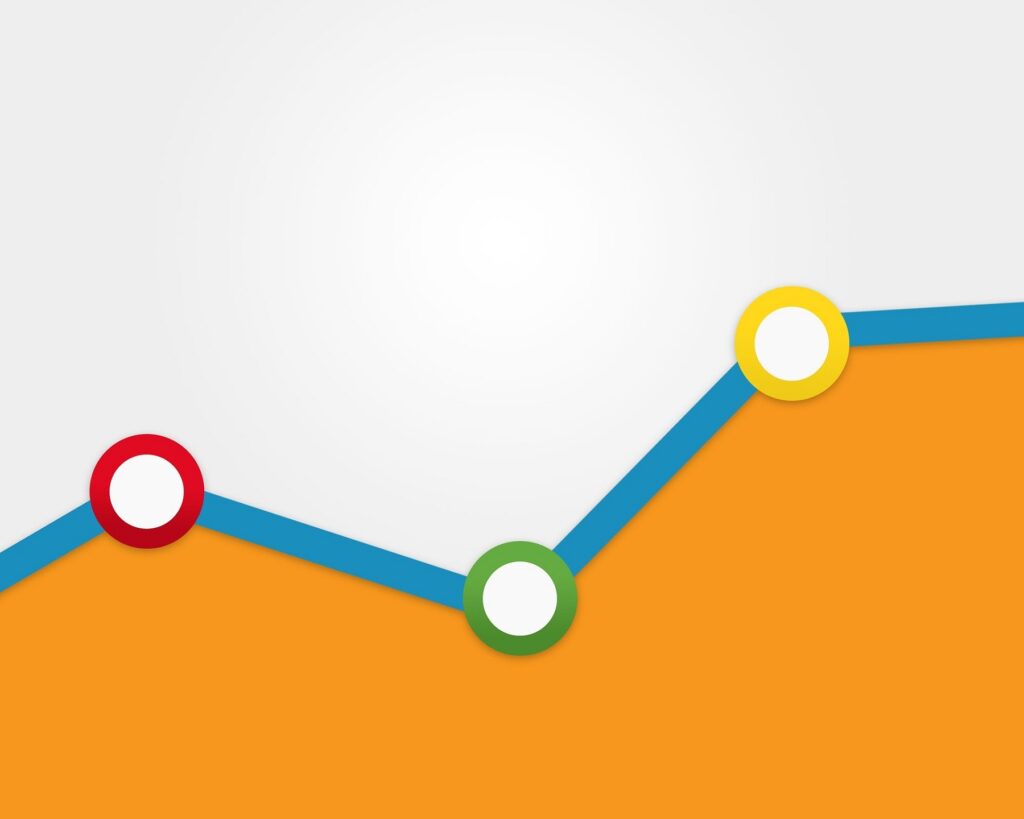
The conversion rate is therefore an essential indicator, since it measures the effectiveness of a communication campaign, a sales funnel or any other marketing process aiming to produce beneficial results for the company. Calculating this rate is the first step: it enables you to identify and address potential obstacles in order to boost your performance. Let’s take a closer look at how to calculate a conversion rate and how to interpret this notorious tool.
What is a conversion rate?
To put it simply, the conversion rate measures the ratio between the number of Internet users who have completed an action on a website and the total number of visitors to the same site.
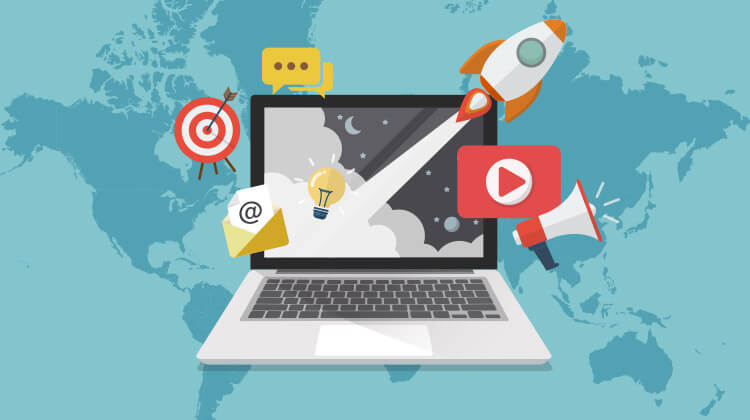
By “conversion”, we imply the completion of a given action, considered as the end of a marketing journey. The notion of completed action is flexible and can be adapted to the company’s objectives. Therefore, if conversion generally refers to an online purchase (of a product or a service), it can also apply to:
- Registering for something (newsletter, course, training…);
- Downloading a document;
- Submitting a form;
- Participating in an event (game, contest, trade fair, conference, cultural or sports event…);
- Installing a mobile application or software;
- Making an appointment;
- Etc.
It all depends on the sector of activity and the commercial objectives. As a performance indicator, the conversion rate makes sense primarily for e-commerce sites and, more generally, for all market players who sell products or services: in this context, it is one of the most relevant tools to measure the success of a campaign or strategy. The goal is not only to generate traffic, but also to encourage visitors to make a purchase. In this respect, conversion is part of a more general process called “conversion tunnel” (or “funnel” in Anglo-Saxon jargon) which consists of following a “lead” from their first contact with a brand to their final transformation into a customer, to make sure they are not lost along the way.
How to calculate a conversion rate?
The conversion rate thus indicates the ratio between the number of visitors of a website having accomplished an action and the total number of Internet users who have visited the site. The calculation is based on a given time frame:
Number of conversions / number of visits x 100
For a website that registers 10,000 visitors in a month, if 500 visitors have completed the desired action, then we calculate: 500 / 10,000 x 100 = 5%.
This is a “simple” way to calculate the conversion rate. This method takes into account the total number of visits to the entire website, which requires that all pages viewed (even if they have no connection to the subject of the marketing message) and all sessions recorded are included in the calculation.
Now, this is a first step, but it is still rather inaccurate. Fortunately, there are other methods to calculate the conversion rate more accurately, using values that are more relevant to the campaign being measured. For instance, you can take into account the total number of:
- sessions;
- unique visitors;
- leads generated;
- visitors on a single page.
Considering the last value, it would make sense if you had launched an SEA campaign targeting a specific landing page. This way, your conversion rate will measure the number of users who converted on your landing page, comparing it to the number of users who clicked on the sponsored link and visited only that particular page, thus excluding other pages on the website. This is a way to determine the conversion rate for this ad referring to this specific page, thus measuring more accurately your return on investment.
How to interpret the conversion rate?
We have seen how the conversion rate calculation measures the number of people who actually do what is expected of them, compared to the total number of people targeted by the marketing message. The aim of the game is to measure the success of a marketing campaign or process, for example a landing page, a form, an advertisement on Google Ads or an entire sales funnel, and to make decisions based on the achieved results. Based on this indicator, you can:
- Determine if your actions have reached their objectives;
- Gage the impact of your marketing actions on your audiences (for example: knowing if these actions satisfy their needs and expectations);
- Measure the profitability of a marketing campaign or process;
- Identify the obstacles that prevent you from generating conversions and that hinder your digital strategy;
- Correct mistakes and reorient your strategy.
The analysis of this indicator becomes particularly relevant within the framework of a CRO (“conversion rate optimisation”) strategy. As long as rates are calculated accurately, based on relevant values such as the number of unique visitors or leads, it becomes easy to identify flaws in the conversion path and to make the necessary adjustments to improve the funnel as a whole.
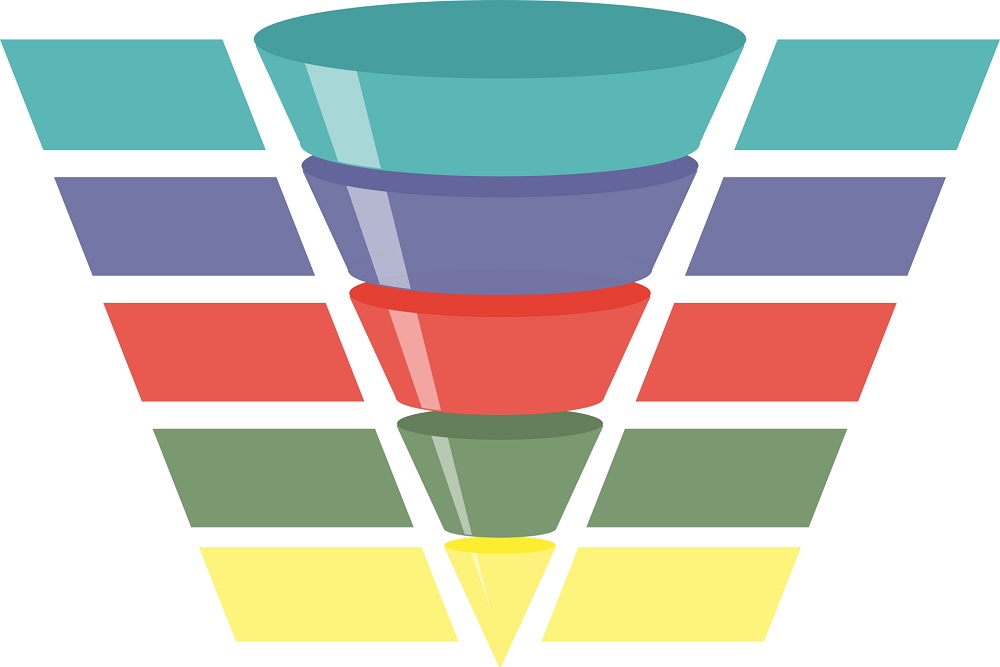
Nevertheless, like all marketing indicators, this one must be handled with care: the information it provides cannot be interpreted without taking into account other factors such as the sector of activity, the average value of the shopping basket and other KPIs.
What is a good conversion rate?
Let’s look at it this way: What objectively constitutes a “good” conversion rate? If you have already reached 5% or 10%, should you consider that you have reached the limit and that you cannot go any higher? Or do you still have room to grow?
According to Wordstream, the average conversion rate is 2.35%, but there are significant variations. For example, 25% of top companies have an average rate of 5.31%, which is more than twice the total. On Google Ads, the most effective advertisers reach 11.45%. In addition, some well optimized e-commerce sites are running at around 20%, mainly because their SEO links or SEA ads are very well targeted.
However, these figures depend largely on the sector of activity. The concept of a “good” conversion rate must therefore be widely moderated, and take into account the commercial ecosystem in which you navigate. To illustrate the potential differences between sectors, but also between the types of products sold in e-commerce, take a look at these two graphs:
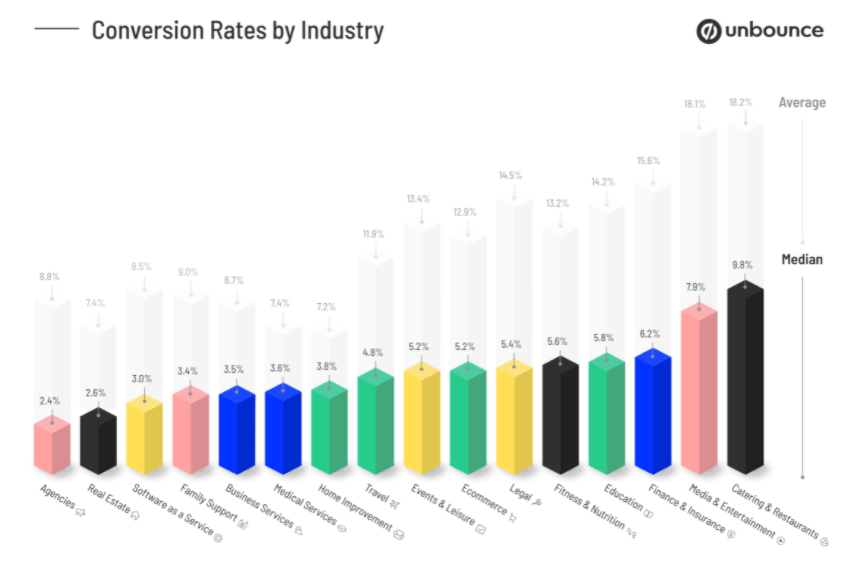
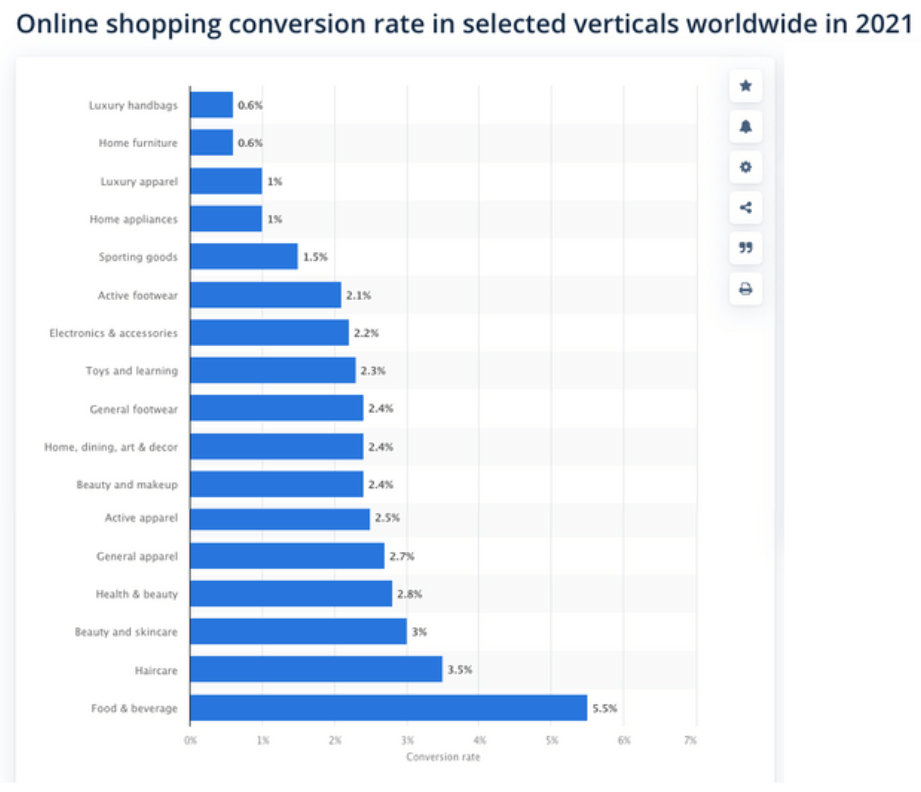
(Source : smartinsights.com)
The first graph shows a significant variation depending on the sector of activity. On the one hand, Agencies (communication, consulting, marketing…) and Real Estate professionals show median rates of 2.4 and 2.6%, while on the other hand, Catering and Restaurants peak at 9.8%. The average rates are even higher: 8.8 and 7.4% for Agencies and Real Estate, compared to 18.2% for Catering and Restaurants.
The second graph highlights how the conversion rate is likely to vary depending on the product sold. We can observe that it is almost ten times higher for Food and beverage than for Luxury handbags; but this indicator does not take into account the price of the goods, which influences the amount of the average shopping basket, which in turn has a significant impact on the profitability of campaigns.
Considering the above, one might think that the solution is to compare one’s conversion rate with the best players in a given sector (or market). For example, a tour operator should know where it stands in relation to the average travel professional (i.e., 11.9%). Yet, it is not that simple, since business models vary greatly. Thus, there are other criteria to be taken into account when balancing the conversion rate:
- Range and price of products or services,
- Brand positioning (B2C or B2B),
- Sources of recorded traffic;
- Geographical location of targeted audiences;
- Etc.
Conversion rate: a reference index
As you can see, the best way to interpret the conversion rate is to compare it with other equally relevant indicators that will provide you with a global vision of the digital strategy or campaign. In other words: use the conversion rate as a reference index from which to evaluate other components.
What components? The bounce rate, for example. This is equally important, provided that it is combined with other indicators. In fact, the notion of conversion is most often accurately applied to sites whose performance is related to the number of pages consulted by Internet users, who must click at least once on an element of the page (internal link, CTA button, validation button, etc.) to convert. Therefore, the conversion rate is closely linked to the visitors’ behaviour on a given page, and in particular to the retention potential of this page.
Another example: the value of the average basket per customer. It is obvious that an e-commerce site specializing in high-end mobile phones will have a lower conversion rate than a food store, if only because of the difference in the number of visitors registered on the site. However, since the prices of the products are higher in the first case, the profitability is also higher despite a lower number of customers. Thus, a conversion rate of 1% for items with an average cost of €500 will be associated with a higher profitability than a rate of 10% for a store with an average basket per customer of €5. (Hence the interest in taking into account the nature of the products sold, as shown in the second graph commented above).
How to optimize your conversion rate?
You have carefully calculated your conversion rate, comparing it to all the relevant indicators and yet you find it very (too) low in view of your objectives. So you want to improve it. There has to be techniques to achieve this. Which are they?
The “A/B test”
For many marketing experts, the “A/B test” is a kind of miracle solution applicable in all cases. The “A/B test” consists in offering Internet users two slightly different versions of the same content (landing page, email, advertisement…) and to determine which one helps to reach or approach the expected results, in order to identify the “ideal version”, whose model will then be repeated. Some of these experts, being true gurus, promise the earth simply by changing the color of a CTA button or the image that illustrates it.
Beware of the temptation to see “A/B testing” as the solution to all your conversion problems! Of course, these checks (and changes) are essential. However, it is not enough to make a few aesthetic changes to transform a meager conversion rate into outstanding results. Surface optimisations must be done, that’s a fact. However, on their own, they offer only limited benefits and, in most cases, only for a certain period of time.
Optimization of the marketing process
As a matter of fact, improving a conversion rate requires optimizing the entire marketing process. This includes the user experience, which is essential in the digital ecosystem. Even if you possess the best possible conversion page (with the right colours and images), do you really think that users will stay on it long enough to click on the CTA if it takes 20 seconds to display or if its content does not match what was indicated in the clickable link? Of course not.
This enhancement implies the activation of a number of levers, which affect marketing as well as the site’s technical optimisation, including content quality. Here are some of the most important examples:
- Improve the loading speed of the conversion page;
- Present a clear and concise form, with as few fields as possible to fill in;
- Make sure that the page content is relevant to the user, and that it brings added value;
- Offer multiple payment methods and secure transactions (mainly for e-commerce sites);
- Streamline navigation so that the user can easily go from the landing page to other key pages of the site;
- Simplify the steps to register, open an account or buy a product (Amazon’s “1-click” ordering option operates on this principle: one click is enough for the user to buy the product, once the option has been set up);
- Integrate relevant CTA buttons;
- Ensure consistency between the clickable link (SEO or SEA) and the landing page to which it refers, and more generally: keep the promises that have been made;
- Offer a product or service that meets the needs of the target audience;
- Implement complementary sales techniques, such as retargeting (targeting a user who has already purchased or abandoned his basket), up-selling or cross-selling;
- Launch promotional offers;
- Target more efficient acquisition channels;
- Etc.
In short, the conversion rate is a strategic indicator that allows you to keep an eye on your marketing campaigns or your sales funnels, and to evaluate their effectiveness. But, like most performance indicators, it must be carefully interpreted and compared to other components of your digital strategy to be meaningful… and to achieve concrete results!









